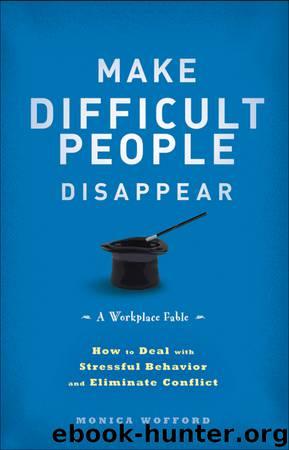Make Difficult People Disappear by Monica Wofford

Author:Monica Wofford
Language: eng
Format: epub
Publisher: Wiley
Published: 2012-03-16T16:00:00+00:00
After lunch, the whole class was put into groups based on their highest-scoring column on the CORE Snapshot™ document they had all filled out in the morning portion of class. They were then asked to assign a leader and come to a consensus on the group’s four most common pet peeves, or things that bugged them in general, as well as a short list of their favorite things to do and the group’s preferred communication style. Of course, the Commanders finished their lists first, and their pet peeves far exceeded four.
The trainer shared the reality of Commander behaviors under slight stress and reminded the group of their tendency to find fault with things that were inefficient or got in the way of the results they craved. The pet peeves they listed included inefficiency, people who didn’t get it, and having to repeat themselves. It was clear that essentially anyone outside of the Commander group seemed to embody the behaviors that appeared on their pet peeve list, and the entire classroom laughed out loud at this realization.
The Commanders finished first because of their repetitive need to compete and win. The praise for that achievement came from an internal source in their own head, but also because of their natural tendency to get things done and move on to the next item. Cybil wondered how often she disregarded a relationship opportunity for the sake of moving to the next thing or failed to notice the internal praise she gave herself for moving so quickly through her list.
The list of items from the Organizer group was equally revealing, as was the way they had written the list on their flip chart. Each item was in sequential order of importance, perfectly lined up and numbered in a neat and tidy fashion. They were more quiet and considerate when they shared their pet peeves, and their favorite things to do were those items that could be done individually versus with a group.
Jason, the CFO, had been chosen as the leader for the Organizers, and he guided the group with precision to come up with the answers that precisely matched the instructions given. When the trainer asked for their preferred communication style, it was clear there had been a struggle to come up with this answer. Team members with their second highest scores in the Relater column craved face-to-face communication to build relationships and to get things right in interpreting the communication, whereas those with high Commander scores as their secondarily dominant preference preferred to communicate via e-mail for its efficiency and ability to get all their thoughts out succinctly and correctly without interruption. They couldn’t decide between the two answers, and in order to most precisely follow the instructions, they took a vote to find the majority winner.
Cybil wondered how often she had shared instructions with a colleague or teammate that had lacked clarity and sounded a bit more like, “Oh, just get that done,” leaving those with the Organizer-dominant preference faced with the need to read her mind to figure out how to accomplish that particular task.
Download
This site does not store any files on its server. We only index and link to content provided by other sites. Please contact the content providers to delete copyright contents if any and email us, we'll remove relevant links or contents immediately.
| Ethics | Etiquette |
| Fashion & Image | Health & Stress |
| Motivation & Self-Improvement | Work Life Balance |
| Workplace Culture |
Tools of Titans by Timothy Ferriss(8211)
Change Your Questions, Change Your Life by Marilee Adams(7633)
Deep Work by Cal Newport(6873)
Man-made Catastrophes and Risk Information Concealment by Dmitry Chernov & Didier Sornette(5921)
Playing to Win_ How Strategy Really Works by A.G. Lafley & Roger L. Martin(5911)
Digital Minimalism by Cal Newport;(5661)
Big Magic: Creative Living Beyond Fear by Elizabeth Gilbert(5609)
The Slight Edge by Jeff Olson(5346)
Ego Is the Enemy by Ryan Holiday(5292)
The Motivation Myth by Jeff Haden(5154)
Stone's Rules by Roger Stone(5026)
The Laws of Human Nature by Robert Greene(4995)
Tuesdays with Morrie by Mitch Albom(4683)
Eat That Frog! by Brian Tracy(4430)
Rising Strong by Brene Brown(4377)
Skin in the Game by Nassim Nicholas Taleb(4161)
Bullshit Jobs by David Graeber(4093)
The Money Culture by Michael Lewis(4073)
Skin in the Game: Hidden Asymmetries in Daily Life by Nassim Nicholas Taleb(3929)
